September 29: Ice falls come from atmosphere, not space. Over the past decade more than fifty ice falls have been confirmed, and several times as many must go unobserved. They are chunks of ice weighing twenty pounds or more that fall from a clear sky. The consensus is that they come from the atmosphere. Now a Spanish scientist, Jesus Martinez-Frias, says the apparent increase in their frequency is a symptom of climate change. (After one fell in Harbord, Australia, on 6 March 2001, we wondered if they came from passing comets. Apparently not.)
 Scientist Says Ice Meteors a Sign of Climate Change, by Emma Ross-Thomas, ABC News, 27 Sep 2002.
Scientist Says Ice Meteors a Sign of Climate Change, by Emma Ross-Thomas, ABC News, 27 Sep 2002.
 Did a chunk of ice fall to Earth from a comet? is the related CA What'sNEW item, 19 March 2001.
Did a chunk of ice fall to Earth from a comet? is the related CA What'sNEW item, 19 March 2001.
 Comets... is a related CA webpage.
Comets... is a related CA webpage.
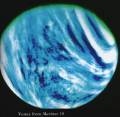 September 25:
September 25:
Bacteria in atmosphere of Venus? University of Texas researchers Dirk Schulze-Makuch and Louis Irwin suggest that mysterious dark patches in Venus's atmosphere may be vast communities of hardy bacteria. 'The researchers found hydrogen sulphide and sulphur dioxide, gases that normally react with each other and thus are never found together unless something is producing them. They also found carbonyl sulphide, a gas that normally only comes from a biological source. "There may be non-biological ways to produce the hydrogen sulphide or carbonyl sulphide that we don't know about, but both reactions need catalysts to proceed efficiently.... On Earth, the most efficient catalysts are microbes."' The suggestion was announced last week at a European workshop on astrobiology in Graz, Austria, and is published in the latest issue of New Scientist. [Thanks, Larry Klaes.]
 Oliver Morton, "Don't Ignore the Planet Next Door" [abstract], p 1706-1707 v 298 Science, 29 Nov 2002.
Oliver Morton, "Don't Ignore the Planet Next Door" [abstract], p 1706-1707 v 298 Science, 29 Nov 2002.
 Acidic clouds of Venus could harbour life, by Stuart Clark, NewScientist.com, 25 Sep 2002.
Acidic clouds of Venus could harbour life, by Stuart Clark, NewScientist.com, 25 Sep 2002.
 Venus a hell? No, it could be a haven, say scientists, SpaceDaily.com, 25 Sep 2002.
Venus a hell? No, it could be a haven, say scientists, SpaceDaily.com, 25 Sep 2002.
 Cloud Colonies on Venus, by Leslie Mullen, Astrobiology Magazine online, 13 Nov 2002.
Cloud Colonies on Venus, by Leslie Mullen, Astrobiology Magazine online, 13 Nov 2002.
 Gaia is a related CA webpage.
Gaia is a related CA webpage.
 Life on Europa...? is the CA webpage for What'sNEW about extraterrestrial (and extramartian) life.
Life on Europa...? is the CA webpage for What'sNEW about extraterrestrial (and extramartian) life.
September 25:
Bacteria evolved on Mars? Russian scientists calculate that Deinococcus radiodurans couldn't have acquired its resistance to extreme radiation on Earth — the exposure level and time were inadequate. Anatoli Pavlov and his colleagues from the Ioffe Physico-Technical Institute in St. Petersburg reached this conclusion after trying to induce the same level of resistance in e. coli. However, they note, there would have been enough time on Mars, where the exposure level is higher than Earth's. "David Morrison of NASA's Astrobiology Institute is sceptical that Deinococcus came from Mars, pointing out that its genome looks similar to those of other Earthly bacteria. But he admits that there's still no obvious explanation for the bug's resistance to radiation." [Thanks, Bill Thomas.]
 Tough Earth bug may be from Mars, NewScientist.com, 25 Sep 2002.
Tough Earth bug may be from Mars, NewScientist.com, 25 Sep 2002.
 Life on Mars! is a related CA webpage.
Life on Mars! is a related CA webpage.
September 18:
Water on extrasolar planets? Italian astronomers have found signs of water in the atmospheres of three planets orbiting distant stars. Cristiano Cosmovici, of the Institute for Cosmic and Planetary Science in Rome, told New Scientist magazine today that his team detected the telltale microwaves with the 32-yard radio telescope near Bologna. [Thanks, Jerry Chancellor.]
 Water Worlds, by Leslie Mullen, Astrobiology Magazine, 30 Sep 2002.
Water Worlds, by Leslie Mullen, Astrobiology Magazine, 30 Sep 2002.
 Signs of Water Found in Atmosphere of Far Planets, Reuters.com, 18 Sep 2002.
Signs of Water Found in Atmosphere of Far Planets, Reuters.com, 18 Sep 2002.
 Signs of Water Found on distant planets, NewScientist.com, 19 Sep 2002.
Signs of Water Found on distant planets, NewScientist.com, 19 Sep 2002.
September 4:
Macroevolutionary Progress Redefined... An essay that introduces a new approach to the question of macroevoutionary progress in a closed system has been added to this website.
 Macroevolutionary Progress Redefined: Can It Happen Without Gene Transfer? is the new CA webpage.
Macroevolutionary Progress Redefined: Can It Happen Without Gene Transfer? is the new CA webpage.
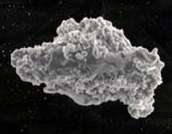 August 25:
August 25:
Conference anticipates Stardust — Don Brownlee, chief scientist for the Stardust mission, heads a group that will sponsor a conference, "Cometary Dust in Astrophysics" next year. At a resort in Washington State, four months before the spacecraft is scheduled to collect dust near comet Wild 2, conferees will consider "expected scientific impact of returned comet samples." [Thanks, Ron Baalke.]
 Cometary Dust In Astrophysics, Crystal Mountain, Washington State, 10-14 August 2003.
Cometary Dust In Astrophysics, Crystal Mountain, Washington State, 10-14 August 2003.
 Comet Rendezvous is a related section of the CA webpage "Can the Theory Be Tested?"
Comet Rendezvous is a related section of the CA webpage "Can the Theory Be Tested?"
 August 24:
August 24:
"Titan has long puzzled scientists because of several unexplained features in its thick, hazy atmosphere, composed largely of solid organic materials. Voyager images taken in 1980, for example, show that the haze is much brighter at Titan's summer hemisphere than at its winter hemisphere. Earth-based observations also show that this difference in brightness changes with Titan's seasons." In Nature two French atmospheric scientists and NASA's Chris McKay propose a mechanism to account for the distribution and behavior of Titan's organic haze. Meanwhile, we think that abundant organic compounds, wherever found, may have been biologicallly produced. In 2004, the Cassini space probe should provide a closer look at Titan, the huge moon of Saturn.
 P. Rannou, F. Hourdin and C. P. McKay, "A wind origin for Titan's haze structure," p 853-856 v 418 Nature, 22 August 2002.
P. Rannou, F. Hourdin and C. P. McKay, "A wind origin for Titan's haze structure," p 853-856 v 418 Nature, 22 August 2002.
 Robert E. Samuelson, "Planetary science: Smog report," p 833-834 v 418 Nature, 22 August 2002.
Robert E. Samuelson, "Planetary science: Smog report," p 833-834 v 418 Nature, 22 August 2002.
 NASA Researchers Find Wind Blows in Titan's Organic Haze, NASA Newsrelease 02-93AR, Kathleen Burton, NASA Ames Research Center, 23 August 2002.
NASA Researchers Find Wind Blows in Titan's Organic Haze, NASA Newsrelease 02-93AR, Kathleen Burton, NASA Ames Research Center, 23 August 2002.
 ...Life on Europa or Other Moons? lists new developments on this subject.
...Life on Europa or Other Moons? lists new developments on this subject.
 August 23:
August 23:
"Cosmic smog may have seeded life not only on our planet, but in countless other solar systems throughout the galaxy," says New Scientist magazine's article about polycyclic aromatic hydrocarbons (PAHs) in space. Chemist Richard Zare of Stanford University will report to the American Chemical Society meeting in Boston this week on investigations into PAHs contained in meteorites. They appear to have changed little in 4.6 billion years, so they must be an enduring feature of the galaxy. From this analysis the team speculates that the PAH's probably contributed to the origin of life on Earth and lots of other places. [Thanks, Newshub.]
 Cosmic smog 'key to life in the Milky Way', by Jeff Hecht, New Scientist, 24 August 2002.
Cosmic smog 'key to life in the Milky Way', by Jeff Hecht, New Scientist, 24 August 2002.
We respect the analysis, but have doubts about the speculation. For one thing, when complex organic compounds were first observed in deep space, chemists were surprised, because they had thought that only biological processes could make complex organic compounds in large quantities. Strictly chemical sources for them were proposed only post facto. We think that a biological source may still be the correct one. For another thing, the origin of life is nowhere close to being a proven phenomenon.
 ...Interstellar Dust is a related CA webpage.
...Interstellar Dust is a related CA webpage.
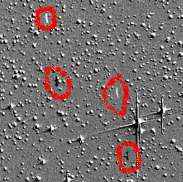 August 21:
August 21:
CONTOUR found; mission is probably doomed. NASA sees two streaks moving across the star field during a 22-minute interval in the double-exposed photo at right. These are deemed to be the two pieces of the spacecraft.
 Tony Reichhardt, "Comet mission collapses as craft disappears," p 806 v 418 Nature, 22 August 2002.
Tony Reichhardt, "Comet mission collapses as craft disappears," p 806 v 418 Nature, 22 August 2002.
 Six Days and Still No Signal, contour2002.org, 21 August 2002.
Six Days and Still No Signal, contour2002.org, 21 August 2002.
 'Very Little Hope' for NASA's Comet-Chasing Craft, by Deborah Zabarenko, Reuters, Yahoo!News, 21 August 2002.
'Very Little Hope' for NASA's Comet-Chasing Craft, by Deborah Zabarenko, Reuters, Yahoo!News, 21 August 2002.
 Contour spacecraft found orbiting sun, by Andrew Bridges, AP, Nando Times, 21 August 2002.
Contour spacecraft found orbiting sun, by Andrew Bridges, AP, Nando Times, 21 August 2002.
 Comet Rendezvous is a related section of the CA webpage "Can the Theory Be Tested?"
Comet Rendezvous is a related section of the CA webpage "Can the Theory Be Tested?"
 August 19:
August 19:
New evolution theory is survival by gene sharing — This is the subtitle of an article about work by Carl Woese and Gary Olsen of the University of Illinois. "Gene transfers have played an incredibly important role in allowing organisms to share their abilities and to acquire new ones, not by inventing them or inheriting them from their ancestors, but from actually acquiring them from other cells in the environment," Olsen said. We welcome the recognition of this phenomenon. Interestingly, the article begins, "Life on Earth did not start just once, as biology books have long taught, but possibly millions of times." This possibility would make our failure to demonstrate the origin of life more striking than ever. [Thanks, Stan Franklin.]
 Ronald Kotulak, "By fits and starts, life may have begun" [text], Chicago Tribune, 12 August 2002.
Ronald Kotulak, "By fits and starts, life may have begun" [text], Chicago Tribune, 12 August 2002.
 The RNA World is a related CA webpage about origin-of-life theories.
The RNA World is a related CA webpage about origin-of-life theories.
 Viruses... is a related CA webpage. [Next-What'sNEW about HGT-Prev]
Viruses... is a related CA webpage. [Next-What'sNEW about HGT-Prev]
 The Tree of Life is a related CA webpage with references to Carl Woese.
The Tree of Life is a related CA webpage with references to Carl Woese.
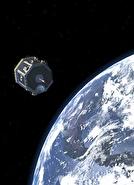 August 16:
August 16:
Contact with CONTOUR comet probe lost — The spacecraft was supposed to fire its rockets to send it out of Earth orbit, but yesterday afternoon it was not seen on its intended path. Still no contact this morning. NASA will continue to look for it. [Thanks, George Stratton, Ron Baalke and Larry Klaes.]
 Associated Press, "NASA Keeps Hunting for Comet Chaser" [text], Los Angeles Times, 18 August 2002.
Associated Press, "NASA Keeps Hunting for Comet Chaser" [text], Los Angeles Times, 18 August 2002.
 Usha Lee McFarling, "Spacecraft Might Have Broken Up" [text], Los Angeles Times, 17 August 2002.
Usha Lee McFarling, "Spacecraft Might Have Broken Up" [text], Los Angeles Times, 17 August 2002.
 CONTOUR comet probe may have broken up in flight, by Wiliam Harwood, Spaceflight Now, 16 August 2002.
CONTOUR comet probe may have broken up in flight, by Wiliam Harwood, Spaceflight Now, 16 August 2002.
 NASA Comet-Chasing Spacecraft Lost, Associated Press, ABC News, 16 August 2002.
NASA Comet-Chasing Spacecraft Lost, Associated Press, ABC News, 16 August 2002.
 Warren E. Leary, "Comet-Exploring Spacecraft Has Disappeared, NASA Says" [text], The New York Times, 16 August 2002.
Warren E. Leary, "Comet-Exploring Spacecraft Has Disappeared, NASA Says" [text], The New York Times, 16 August 2002.
 Mission Operations Awaiting Contact from CONTOUR Spacecraft, contour2002.org, 15 August 2002.
Mission Operations Awaiting Contact from CONTOUR Spacecraft, contour2002.org, 15 August 2002.
 Comet Rendezvous is a related section of the CA webpage "Can the Theory Be Tested?"
Comet Rendezvous is a related section of the CA webpage "Can the Theory Be Tested?"
 August 3:
August 3:
NASA team reinforces case for biological magnetites in ALH84001 — In the latest issue of Applied and Environmental Microbiology an international team of nine researchers led by Kathie Thomas-Keprta reports on the results of a three-year study. "A comparison between [certain magnetites] in the meteorite and crystals known to be produced by Earth-bacteria MV-1 is striking and provides strong evidence that [the magnetites] were made by bacteria on Mars." [Thanks, Ron Baalke and Jim McGee.]
 Kathie L. Thomas-Keprta et al. "Magnetofossils from Ancient Mars: a Robust Biosignature in the Martian Meteorite ALH84001" [PDF], p 3663-3672, v 68, Appl. Environ. Microbiol., August 2002.
Kathie L. Thomas-Keprta et al. "Magnetofossils from Ancient Mars: a Robust Biosignature in the Martian Meteorite ALH84001" [PDF], p 3663-3672, v 68, Appl. Environ. Microbiol., August 2002.
 Researchers Publish Latest Results in Continuing Search for Ancient Martian Life, JPL, NASA, 2 August 2002.
Researchers Publish Latest Results in Continuing Search for Ancient Martian Life, JPL, NASA, 2 August 2002.
 ...Latest Results..., astrobio.net, 9 August 2002.
...Latest Results..., astrobio.net, 9 August 2002.
 ...Life on Mars! is the related CA webpage.
...Life on Mars! is the related CA webpage.

August 1: Evolutionary advance from chimps to humans linked to viruses — A study by John McDonald, head of the genetics department at the University of Georgia, and King Jordan at the National Center for Biotechnology Information at the National Institutes of Health "suggests for the first time that a burst of transpositional activity occurred at the same time humans and chimps are believed to have diverged from a common ancestor — 6 million years ago." Consequently, McDonald and Jordan believe, "rather than simply playing a role in human evolution, retroviral elements may actually be implicated in the leap from chimpanzees to humans." Also, "Ancient families of HERVs may be capable of retaining the potential for biological activity over long spans of evolutionary time."
The University of Georgia press release about this research cites related work by two researchers from Tufts University, Jennifer Hughes and John Coffin, who recently identified 23 new Human Endogenous Retroviruses (HERVs). "The widespread presence of these viral elements led Coffin to tell one science magazine that humans probably have 'more viruses in our genes than genes in our genes.'" [Thanks, SciQuest.]
This evidence strongly supports the mechanism that we believe is behind evolutionary progress.
 ...Human Specific [Retoviruses] Developed When Humans, Chimps Diverged, by Phil Williams, University of Georgia, 1 August 2002.
...Human Specific [Retoviruses] Developed When Humans, Chimps Diverged, by Phil Williams, University of Georgia, 1 August 2002.
 I. King Jordan and John F. McDonald, "A Biologically Active Family of Human Endogenous Retroviruses Evolved from an Ancient Inactive Lineage," p 105-109, v1 n2, Genome Letters, June 2002.
I. King Jordan and John F. McDonald, "A Biologically Active Family of Human Endogenous Retroviruses Evolved from an Ancient Inactive Lineage," p 105-109, v1 n2, Genome Letters, June 2002.
 Viruses... is a related CA webpage. [Next-What'sNEW about HGT-Prev]
Viruses... is a related CA webpage. [Next-What'sNEW about HGT-Prev]
 Human Genome Search... is a related CA webpage.
Human Genome Search... is a related CA webpage.
 July 31:
July 31:
Mars sample return? — Orlando Figueroa discusses NASA's plans for future missions to Mars in an interview on Space.com. [Thanks, Ron Baalke.]
 Orlando Figueroa: NASA's Mars Czar Gives a Status Report on Red Planet Plans, by Leonard David, Space.com, 30 July 2002.
Orlando Figueroa: NASA's Mars Czar Gives a Status Report on Red Planet Plans, by Leonard David, Space.com, 30 July 2002.
 ...Life on Mars! is the related CA webpage.
...Life on Mars! is the related CA webpage.
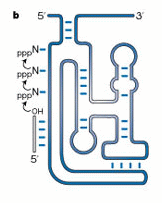 July 27, 2002:
July 27, 2002:
RNA World: the latest — Gerald Joyce surveys in depth the current status of research in the "RNA World," the leading account of the origin of life from nonlife. Joyce is among its foremost experts, and we recommend this article in Nature to anyone seriously interested in the subject. Although Joyce would not agree with our premise that life cannot originate from nonlife, he presents the RNA World fairly, acknowledging many of the problems that confront the theory. For example, he writes:
- "The chief obstacle to understanding the origin of RNA-based life is identifying a plausible mechanism for overcoming the clutter wrought by prebiotic chemistry."
- "The RNA-catalysed reaction must have provided some selective advantage that was not contingent on future evolutionary developments."
To solve some of the problems he suggests, "Some other genetic system preceded RNA, just as it preceded DNA and protein." Thus the "PNA World," the "TNA World" and others are proposed to rescue the RNA World. He also notes:
- "A largely open question concerns the origin of the genetic code."
- "In keeping with the second law of thermodynamics, the increase in order that occurs in a genetic system is achieved through the expenditure of high-energy starting materials that are converted to lower-energy products."
But order is not the same as organization. Furthermore, this process depends on instructions encoded in the genome, but there is no evidence that the expenditure of energy, by itself, has ever added encoded instructions to anything. He continues:
- "Other RNA-based functions for which there is no evidence in biology, such as nucleotide synthesis and RNA polymerization, are assumed to have existed in the RNA world based on first principles, but it is important to recognize that this assumption is not supported by available historical evidence."
- "The above discussion ignores other obstacles to RNA-catalysed RNA replication, such as maintaining a supply of activated mononucleotides, ensuring that the ribozyme will recognize its corresponding genomic RNA while ignoring other RNAs in the environment, overcoming stable self-structure within the template strand, separating the template and product strands, and operating in a similar manner on the product strand to generate new copies of the template."
According to our word processor, Joyce's article of seven pages, omitting footnotes and figures, consists of 6,332 words in 638 sentences. Among them we counted the following words or expressions:
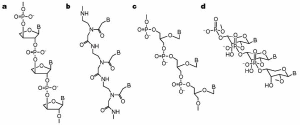 XNA Worlds? XNA Worlds? |
- 39 "may [might, could or must] have"
- 8 "perhaps" or "may be"
- 13 "if"
- 13 "possible" or "possibility"
- 8 "probably" or "likely"
- 6 "not difficult to [one could] imagine [conceive, visualize]"
- 5 "not clear" or "not yet"
- 92 Total, or one of these about every 7 sentences
In the 75 years since Oparin and Haldane initiated the modern theory of life's origin from nonlife we have learned very much about how life operates and nothing about how it originates. Without abandoning science, we should wonder whether we are asking the right question.
 Gerald F. Joyce, "The antiquity of RNA-based evolution," doi:10.1038/418214a, p 214-221 v 418, Nature, 11 July 2002.
Gerald F. Joyce, "The antiquity of RNA-based evolution," doi:10.1038/418214a, p 214-221 v 418, Nature, 11 July 2002.
 The RNA World is a related CA webpage.
The RNA World is a related CA webpage.
 22 Aug 2023: Ttwenty-one years later, is it time for a radical alternative?
22 Aug 2023: Ttwenty-one years later, is it time for a radical alternative?
July 26:
Glycine in space — One of life's building blocks has been identified by its spectral signature emanating from giant molecular clouds in space. Most commentators asume it must have been made nonbiologically. We say, not necessarily.
 Amino acid found in deep space, by Rachel Nowak, New Scientist, 18 July 2002.
Amino acid found in deep space, by Rachel Nowak, New Scientist, 18 July 2002.
 ...Analysis of Interstellar Dust is the related CA webpage.
...Analysis of Interstellar Dust is the related CA webpage.
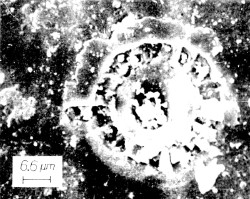 July 23:
July 23:
Search for early Earth microbes on the Moon? "Dust [from Earth] has been piling up on the moon for billions of years, and now some scientists want to sift through the accumulation to see if they can find evidence of the planet's earliest life.... In an upcoming edition of Icarus, an international journal of solar system science, [John] Armstrong [a University of Washington doctoral student in astronomy and astrobiology], and colleagues Llyd Wells, a UW graduate student in oceanography, and Guillermo Gonzalez, an assistant physics and astronomy professor at Iowa State University, argue that humans should seriously consider returning to lunar exploration... [to] search for fossils of some of Earth's earliest microbial life." We have emailed the authors to direct their attention to the fossils like the one shown, already recovered there by the former USSR's Luna program and described on this website, 27 October 2000. Any followups will be posted there. [Thanks, Larry Klaes.]
 Dust in 'Earth's attic' could hold evidence of planet's earliest life, University of Washington, 22 July 2002.
Dust in 'Earth's attic' could hold evidence of planet's earliest life, University of Washington, 22 July 2002.
 Microorganisms from the Moon is the CA webpage describing the Luna fossils [retracted].
Microorganisms from the Moon is the CA webpage describing the Luna fossils [retracted].
July 14:
Mouse vs Human — A comparison between a mouse chromosome and the parts of the human genome related to it was recently published in Science (1), and some of the conclusions are surprising to mainstream biologists.
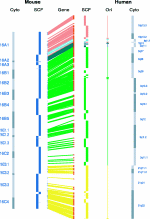
 Firstly, non-coding DNA is much more faithfully conserved than standard Darwinism would predict. Previous evidence of this unexplained conservation was known by the early 1990s, but the new analysis looked at two kinds of indicators, noncoding transposons, and synonymous nucleotide substitutions in working genes. Both showed the same high amount of similarity between the two species that separated 100 (or 90?) million years ago. Science's commentators assume that the conserved nucleotides must somehow convey survival value. How a synonymous nucleotide substitution might weaken a species is not obvious, but the hypothesis could easily be tested in a mouse model. Meanwhile, we can think of another reason for the conservation. Replication, among mammals anyway, might simply be more accurate than formerly believed.
Firstly, non-coding DNA is much more faithfully conserved than standard Darwinism would predict. Previous evidence of this unexplained conservation was known by the early 1990s, but the new analysis looked at two kinds of indicators, noncoding transposons, and synonymous nucleotide substitutions in working genes. Both showed the same high amount of similarity between the two species that separated 100 (or 90?) million years ago. Science's commentators assume that the conserved nucleotides must somehow convey survival value. How a synonymous nucleotide substitution might weaken a species is not obvious, but the hypothesis could easily be tested in a mouse model. Meanwhile, we can think of another reason for the conservation. Replication, among mammals anyway, might simply be more accurate than formerly believed.
 In a related surprise, the study found that "the rate at which different DNA sequences change through time varies significantly" (2). This finding casts additional doubt on the "molecular clocks" used to estimate the divergence times of orthologous genes. Ignoring this issue, we suggest that, in tandem with very accurate replication, the evolutionary system may include a means to permit or promote faster mutation when and where needed. Isolated examples of "adaptive mutation" and even "directed mutation" are already known, but we think the phenomenon might be quite general. In conjunction with gene duplication, it could "easily account for the differences in the way humans and mice taste their food..." (3). (It would not account for wholly new genes.)
In a related surprise, the study found that "the rate at which different DNA sequences change through time varies significantly" (2). This finding casts additional doubt on the "molecular clocks" used to estimate the divergence times of orthologous genes. Ignoring this issue, we suggest that, in tandem with very accurate replication, the evolutionary system may include a means to permit or promote faster mutation when and where needed. Isolated examples of "adaptive mutation" and even "directed mutation" are already known, but we think the phenomenon might be quite general. In conjunction with gene duplication, it could "easily account for the differences in the way humans and mice taste their food..." (3). (It would not account for wholly new genes.)
 In the studied regions, 14 of 731, or 2% of mouse genes have no human counterpart; and 21 of 725, or 2.9% of human genes have no mouse counterpart. If these regions are typical of the whole genomes, "this means that one new gene arose or disappeared on average every 192,000 years" (3). How the new ones might arise is hardly discussed in the analysis or commentaries. Of course the random search method, especially with low mammalian populations and long generation times, is hopeless. Interestingly, the research team notes near the end of their report, "The insertion of retroviral sequences is one of the more dynamic processes in genome evolution.... A full review of this topic is beyond the scope of this study."
In the studied regions, 14 of 731, or 2% of mouse genes have no human counterpart; and 21 of 725, or 2.9% of human genes have no mouse counterpart. If these regions are typical of the whole genomes, "this means that one new gene arose or disappeared on average every 192,000 years" (3). How the new ones might arise is hardly discussed in the analysis or commentaries. Of course the random search method, especially with low mammalian populations and long generation times, is hopeless. Interestingly, the research team notes near the end of their report, "The insertion of retroviral sequences is one of the more dynamic processes in genome evolution.... A full review of this topic is beyond the scope of this study."
1. Richard J. Mural et al. [about 150 authors], "A Comparison of Whole-Genome Shotgun-Derived Mouse Chromosome 16 and the Human Genome" [abstract], p 1661-1671 v 296 Science, 31 May 2002.
2. Elizabeth Pennisi, "Charting a Genome's Hills and Valleys" [summary], p 1601-1603 v 296 Science, 31 May 2002.
3. Neal G. Copeland, Nancy A. Jenkins, Stephen J. O'Brien, "Mmu 16—Comparative Genomic Highlights" [summary], p 1617-1618 v 296 Science, 31 May 2002.
 Neo-Darwinism... and the four pages that follow it are related CA webpages.
Neo-Darwinism... and the four pages that follow it are related CA webpages.
 Metazoan Genes Older Than Metazoa?, a related CA webpage, discusses molecular clocks.
Metazoan Genes Older Than Metazoa?, a related CA webpage, discusses molecular clocks.
 Human Genome Search... is a related CA webpage.
Human Genome Search... is a related CA webpage.
 Lateral DNA Transfer is a related CA What'sNEW item of 11 May 2002. Note especially the bullet point related to mouse genomes.
Lateral DNA Transfer is a related CA What'sNEW item of 11 May 2002. Note especially the bullet point related to mouse genomes.
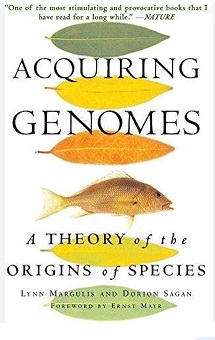 July 7, 2002:
July 7, 2002:
Acquiring Genomes, a new book by Lynn Margulis and Dorion Sagan, contains much that we admire. Margulis is an eminent microbiologist who has long promoted unorthodox ideas, like symbiosis as an important force in evolution, and gaia. Here she and her son claim that "symbiogenesis" solves the dilemma Darwin didn't, the origin of species. The writing is clear and engaging, with helpful explanations introducing results of the latest research. We felt both edified and confirmed by the book. Among the sentences we especially liked were:
- Honest critics... who have emphasized the problems with biologists' dogma... are often dismissed as if they were Christian fundamentalist zealots... (p 18-19).
- We believe random mutation is wildly overemphasized as a source of hereditary variation (p 11).
- Never, however, did that one mutation make a wing, a woody stem, or a claw appear. Mutations, in summary, tend to induce sickness, death, or deficiencies (p 29).
- Natural selection does not generate new forms; it does not innovate (p 67).
- Mutations refine and hone (p 72).
- The important transmitted variation that leads to evolutionary novelty comes from the acquisition of genomes (p 12).
- Microbes are champions at passing their DNA to others in the form of entire functioning genes (p 41).
- Organisms also gain new hereditary traits by the accumulation of viruses, or of plasmids or other short pieces of DNA (p 75).
- 'Trees of life'... bearing only diverging branches... do not reflect life's history on Earth (p 33).
- The luxuriant living diversity surrounding us did not evolve gradually (p 96).
 Lynn Margulis and Dorion Sagan, Acquiring Genomes: A Theory of the Origins of Species, Foreword by Ernst Mayr, ISBN: 0465043917; 256 pages, $19.60; Basic Books; 18 June 2002.
Lynn Margulis and Dorion Sagan, Acquiring Genomes: A Theory of the Origins of Species, Foreword by Ernst Mayr, ISBN: 0465043917; 256 pages, $19.60; Basic Books; 18 June 2002.
 Neo-Darwinism... and the four pages that follow it are related CA webpages.
Neo-Darwinism... and the four pages that follow it are related CA webpages.
 Viruses... is a related CA webpage. [Next-What'sNEW about HGT-Prev]
Viruses... is a related CA webpage. [Next-What'sNEW about HGT-Prev]
 The Tree of Life is a related CA webpage.
The Tree of Life is a related CA webpage.